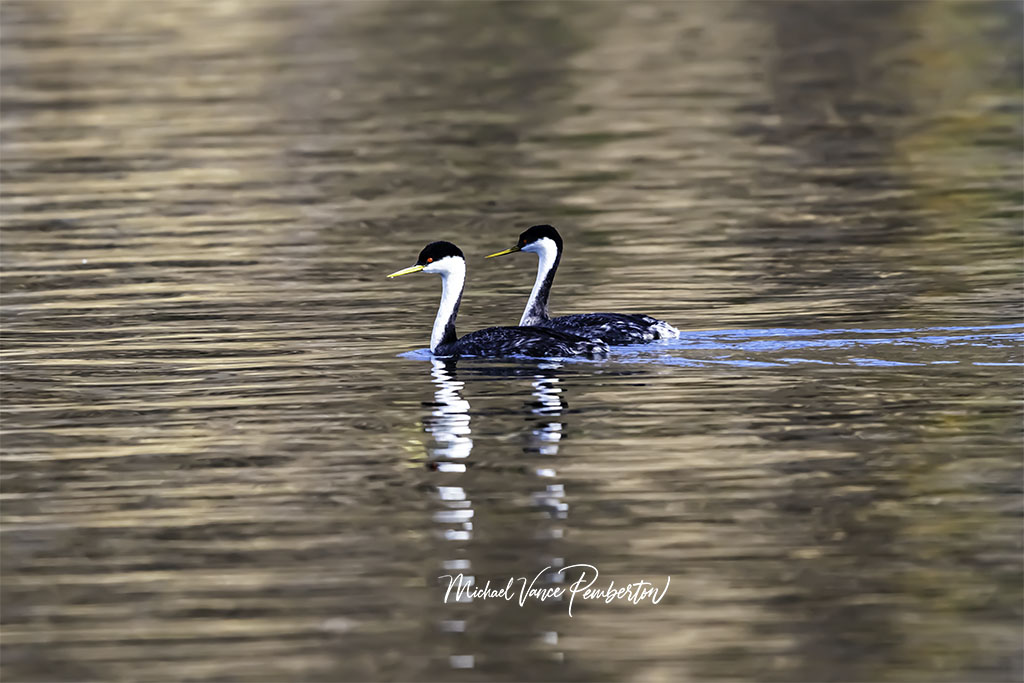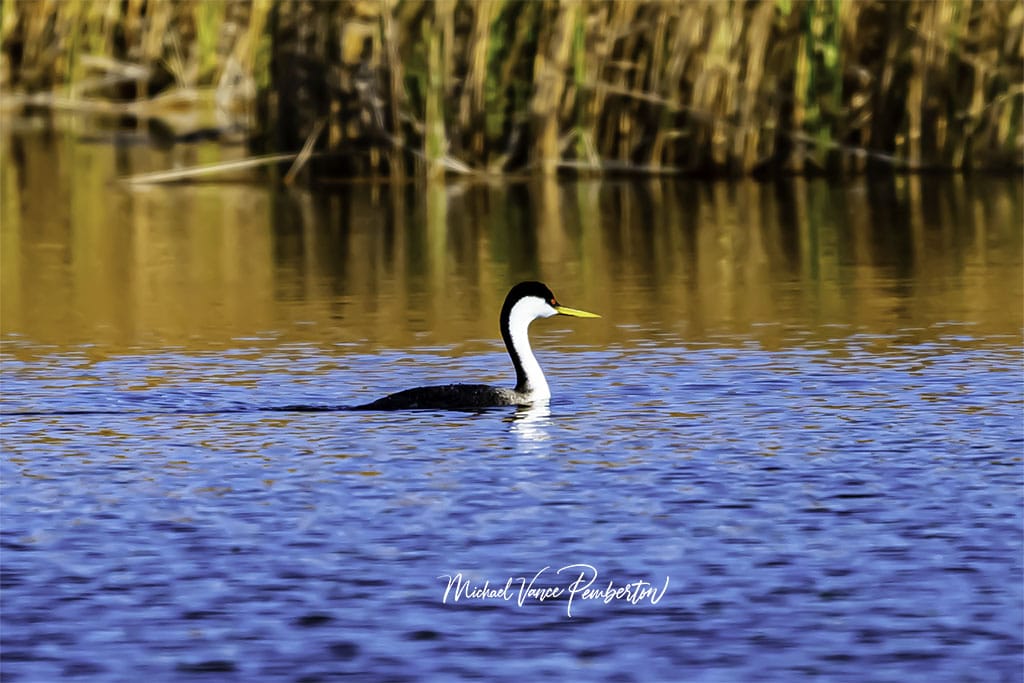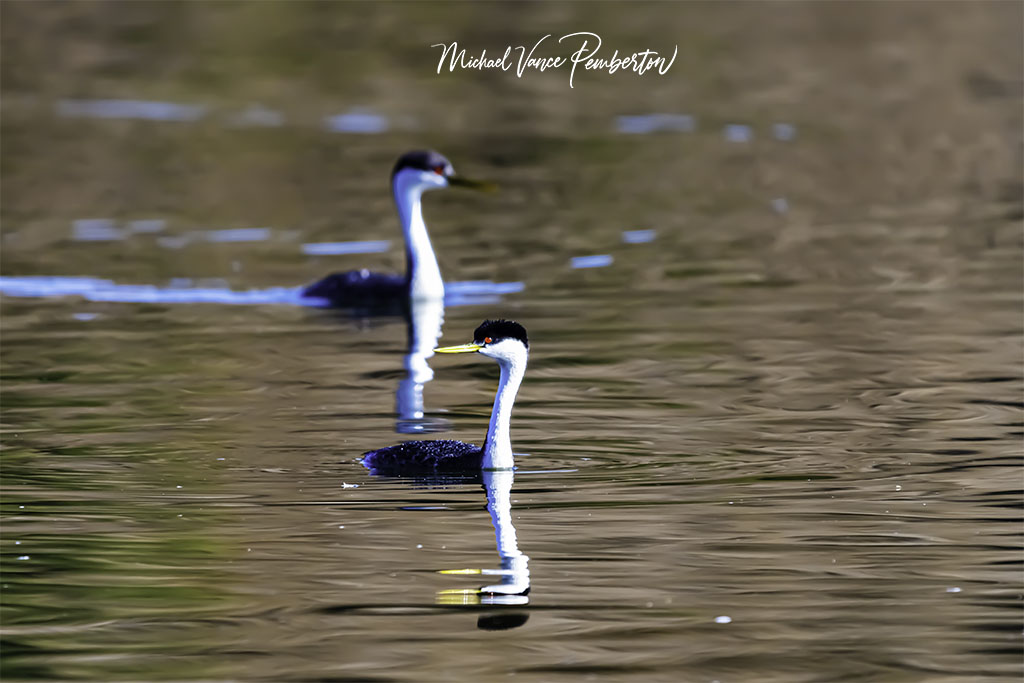The Western Grebe, known scientifically as Aechmophorus occidentalis, is a stunning waterbird in North America. With its striking black-and-white plumage and long, slender neck, this elegant bird is a favorite subject for wildlife photographers. In this article, we will delve into Western Grebe photography and explore why these birds are essential to capture through the lens.

Western Grebe: An Overview:
Western Grebes are aquatic birds that belong to the Podicipedidae family. They are primarily found in freshwater lakes, ponds, and rivers across North America, extending from Canada to Mexico. These birds are known for their distinctive appearance, featuring a black cap and neck contrasting beautifully with a white body. Their eyes take on a striking red hue during the breeding season, adding to their allure.
Why Photograph Western Grebes?
Aesthetic Appeal:
Western Grebes are renowned for their graceful courtship displays, making them an enchanting subject for wildlife photographers. This extraordinary behavior occurs during the breeding season, a spectacle that genuinely sets Western Grebes apart. As the male and female Western Grebes come together in pairs, they begin mesmerizing synchronized dances on the water’s surface. This elegant choreography is a vital part of their courtship and a captivating scene for photographers to capture.
These dances involve a series of intricate movements that showcase the agility and grace of these birds. The most iconic aspect of this display is how the birds appear to run on water, a behavior known as “rushing.” With their long, slender necks outstretched and their bodies almost horizontal, they glide swiftly across the water’s surface. This motion creates delicate ripples and patterns on the water, adding a layer of beauty to the scene.
The synchronized nature of these dances is genuinely remarkable. The pairs of Western Grebes move in perfect harmony, mirroring each other’s movements as they dance together. Their coordinated actions create a symphony of visually striking and emotionally evocative motion. Photographers have the privilege of capturing this fleeting moment, freezing it in time for others to marvel at.
Photographing these courtship displays requires patience and precision. Wildlife photographers must be ready to observe and anticipate these behaviors, as they can happen suddenly and sporadically. Using a telephoto lens becomes essential, as it allows photographers to capture the intricate details of the birds’ plumage and expressions without intruding on their intimate moments.
The images produced during these courtship displays tell a story of love, grace, and the wonders of the natural world. Beyond their aesthetic appeal, these photographs play a vital role in conservation efforts by highlighting the beauty and fragility of the Western Grebes’ habitat. They inspire admiration and respect for these birds and their ecosystems, fostering a deeper appreciation for the need to protect and preserve them for future generations. In essence, capturing the Western Grebes in their courtship displays is not just about creating visually stunning images; it’s about sharing a profound and awe-inspiring aspect of nature with the world.

Unique Behavior:
Observing and capturing Western Grebes engaging in their courtship rituals is an extraordinary privilege, offering a rare glimpse into the intricacies of avian behavior. These courtship displays are a testament to the marvels of nature and represent a unique phenomenon in the avian world. As photographers, we are fortunate to document and share this captivating natural spectacle with the world.
In the vast and diverse realm of birds, the courtship rituals of Western Grebes stand out as a truly remarkable and singular event. Unlike the more common displays seen in many bird species, such as songs and elaborate plumage exhibitions, Western Grebes perform ballet on the water. This behavior expresses their deep connection and commitment to their mates.
The level of synchronization and precision makes these displays genuinely exceptional. Western Grebe pairs move in perfect harmony, their every movement mirroring each other’s with uncanny accuracy. This synchronized dance is a testament to the strong bonds formed between these birds and their ability to communicate with incredible finesse.
The courtship rituals typically begin with a series of head movements, nodding, and mutual preening to reinforce the bond between the pair. However, when they transition to the “rushing” phase, the magic truly unfolds. As the Western Grebes appear to run on water, their long, slender necks are extended, and their bodies glide gracefully across the surface. This unique behavior is mesmerizing, almost like a choreographed ballet performance.
Photographers fortunate enough to witness these displays are presented with a once-in-a-lifetime opportunity to capture nature’s raw beauty and elegance. The visual storytelling potential is immense, as each image tells the tale of devotion and the intricate rituals these birds perform to secure their bond. The striking contrast between the birds’ black caps and white plumage against the backdrop of the shimmering water creates a composition that is nothing short of breathtaking.
Beyond their aesthetic appeal, these photographs are valuable records of this rare avian behavior. They contribute to our understanding of Western Grebe courtship and can be used for educational purposes and conservation efforts. By documenting these captivating natural phenomena, photographers play a crucial role in raising awareness about preserving the habitats and ecosystems that support these remarkable birds.
Capturing Western Grebes amid their courtship rituals is a testament to the wonders of the natural world and the dedication and skill of wildlife photographers. It offers a unique opportunity to witness a behavior rarely seen in the avian realm, allowing us to appreciate the beauty of nature and inspiring us to protect and conserve these delicate ecosystems for future generations.

Conservation Awareness:
Like numerous other bird species, Western Grebes are confronting many challenges that threaten their habitats and overall survival. These avian wonders, despite their enchanting courtship displays, are not immune to the ever-growing environmental pressures of our world. However, photographers have a unique and influential role in advocating for their conservation. By capturing the beauty and elegance of Western Grebes through their lenses and sharing these images, photographers can be instrumental in raising awareness about the critical need to protect these birds, their ecosystems, and the delicate balance of our environment.
One of the most pressing issues that Western Grebes face is habitat degradation and loss. As human activities continue encroaching upon their natural habitats, these birds find fewer places to call home. Lakes and wetlands, crucial for their breeding and foraging, are being drained, polluted, or altered for various purposes, including agriculture and urban development. Photographers can draw attention to the urgent need to conserve and restore these vital ecosystems by photographing Western Grebes in these habitats and highlighting their significance.
Another significant threat to Western Grebes, as well as many other bird species, is the impact of climate change. Rising temperatures, altered precipitation patterns, and more frequent extreme weather events can disrupt the availability of prey species and nesting conditions. Documenting the effects of climate change on Western Grebe populations, such as changes in their distribution or nesting behavior, can serve as robust visual evidence of the ecological consequences of global warming. These photographs can inspire action to mitigate climate change and its impact on wildlife.
Furthermore, pollution, notably water pollution, poses a significant risk to Western Grebes. Pesticides, heavy metals, and other contaminants find their way into the water bodies these birds rely on, affecting both their food sources and their health. Photographers can shed light on the detrimental effects of pollution by photographing Western Grebes in polluted environments and advocating for stricter regulations to protect these fragile ecosystems.
Overfishing and the depletion of fish stocks, a vital food source for Western Grebes, also contribute to their challenges. Photographs of Western Grebes struggling to find enough food due to overfishing can help illustrate the importance of sustainable fishing practices and the need for responsible resource management.
Western Grebes are ambassadors for various environmental issues, from habitat destruction and pollution to climate change and overexploitation of natural resources. Through a camera lens, photographers can bring attention to these issues, engaging a broader audience and fostering a sense of empathy for these magnificent birds and the ecosystems they inhabit. By sharing their images through various platforms, photographers become advocates for change, inspiring individuals, communities, and policymakers to take action to protect the delicate balance of our environment and secure a future for Western Grebes and other threatened species.
Tips for Photographing Western Grebes
- Location Scouting: Knowing where to find Western Grebes is crucial for successful photography. Look for them in their preferred habitats, such as large freshwater lakes, especially during the breeding season.
- Timing Matters: The best time to photograph Western Grebes is during their courtship and breeding season, typically in the spring and early summer. During this period, they are more active and engaging in their distinctive displays.
- Equipment: A telephoto lens (300mm or longer) is essential for capturing these birds from a distance without causing disturbance. A stable tripod or monopod is also invaluable for achieving sharp images, especially when photographing from a distance.
- Patience is Key: Wildlife photography often requires long periods of waiting. Western Grebes can be shy and easily startled, so be patient and allow them to become accustomed to your presence.
- Ethical Photography: Always prioritize the welfare of the birds and their environment. Maintain a respectful distance, avoid disturbing nests or nesting sites, and follow ethical wildlife photography guidelines.
Conclusion:
Photographing Western Grebes offers a unique opportunity to capture the beauty of these elegant waterbirds and share their fascinating courtship displays with the world. Through your lens, you can highlight the importance of conservation efforts and inspire others to appreciate and protect the delicate ecosystems that Western Grebes call home. Remember to approach your photography with care and respect for these birds and their environment, ensuring that your images contribute positively to art and conservation.


Recent Posts
In shadows cast by love's deceitful guise,He wandered blind, his heart the captive prize.Through realms unknown, where truth remained concealed,He followed trails of falsehood, unrevealed. Blinded...
Prepare to be amazed as the MCAS Cherry Point Air Show returns on May 11-12. This annual event, hosted by the Marine Corps Air Station (MCAS) Cherry Point in North Carolina, promises a weekend of...